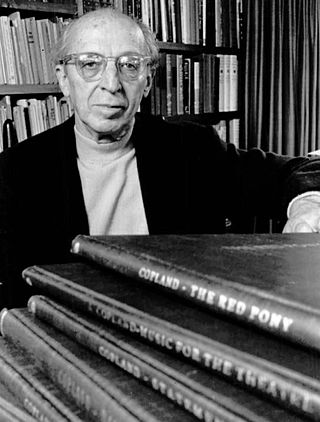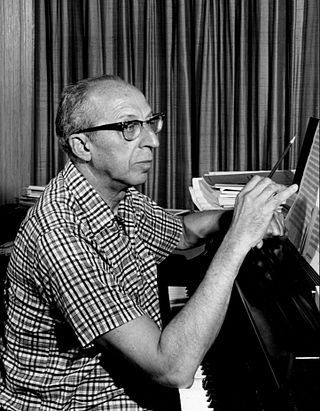Related Research Articles

Aaron Copland was an American composer, critic, writer, teacher, pianist and later a conductor of his own and other American music. Copland was referred to by his peers and critics as the "Dean of American Composers". The open, slowly changing harmonies in much of his music are typical of what many people consider to be the sound of American music, evoking the vast American landscape and pioneer spirit. He is best known for the works he wrote in the 1930s and 1940s in a deliberately accessible style often referred to as "populist" and which the composer labeled his "vernacular" style. Works in this vein include the ballets Appalachian Spring, Billy the Kid and Rodeo, his Fanfare for the Common Man and Third Symphony. In addition to his ballets and orchestral works, he produced music in many other genres, including chamber music, vocal works, opera and film scores.

Charles Edward Ives was an American actuary, businessman, and modernist composer. Ives was amongst the earliest American internationally renowned composers to achieve recognition on a global scale. His music was largely ignored during his early career, and many of his works went unperformed for many years. Later in life, the quality of his music was publicly recognized through the efforts of contemporaries like Henry Cowell and Lou Harrison, and he came to be regarded as an "American original". He was also among the first composers to engage in a systematic program of experimental music, with musical techniques including polytonality, polyrhythm, tone clusters, aleatory elements, and quarter tones. His experimentation foreshadowed many musical innovations that were later more widely adopted during the 20th century. Hence, he is often regarded as the leading American composer of art music of the 20th century.

Works Volume 1 is the fifth studio album by English progressive rock band Emerson, Lake & Palmer, released as a double album in March 1977 on Atlantic Records. Following their world tour supporting Brain Salad Surgery (1973), the group took an extended break before they reconvened in 1976 to record a new album. They were now tax exiles and recorded new material in London and overseas in Montreux, Switzerland and Paris, France. Works Volume 1 features a side dedicated for each member to write and arrange their own tracks, while the fourth side features songs performed collectively. Keith Emerson recorded his Piano Concerto No. 1, Greg Lake wrote several songs with lyricist Peter Sinfield, and Carl Palmer recorded tracks of varied musical styles.
The Trio for Violin, Cello, and Piano is a work by the American composer Charles Ives. According to his wife, the three movements of the piano trio are a reflection of Ives’ college days at Yale. He started writing the piece in 1904, six years after graduation, and completed it in 1911. It was written c.1909–10 and significantly revised in 1914–15.

Connotations is a classical music composition for symphony orchestra written by American composer Aaron Copland. Commissioned by Leonard Bernstein in 1962 to commemorate the opening of Philharmonic Hall in New York City, United States, this piece marks a departure from Copland's populist period, which began with El Salón México in 1936 and includes the works he is most famous for such as Appalachian Spring, Lincoln Portrait and Rodeo. It represents a return to a more dissonant style of composition in which Copland wrote from the end of his studies with French pedagogue Nadia Boulanger and return from Europe in 1924 until the Great Depression. It was also Copland's first dodecaphonic work for orchestra, a style he had disparaged until he heard the music of French composer Pierre Boulez and adapted the method for himself in his Piano Quartet of 1950. While the composer had produced other orchestral works contemporary to Connotations, it was his first purely symphonic work since his Third Symphony, written in 1947.

William Quincy Porter was an American composer and teacher of classical music.

Leonard Bernstein's Sonata for Clarinet and Piano, written during 1941–42 and published in 1942, was Bernstein's first published piece. It is dedicated to clarinetist David Oppenheim, whom Bernstein met while studying conducting with Serge Koussevitzky at Tanglewood during the summers of 1940 and 1941.
Aaron Copland's Clarinet Concerto was written between 1947 and 1949, although a first version was available in 1948. The concerto was later choreographed by Jerome Robbins for the ballet Pied Piper (1951).
The Piano Variations of American composer Aaron Copland were written for piano solo from January to October 1930. They were dedicated to American writer and literary critic Gerald Sykes, and were originally published in 1932 by Cos Cob Press, which merged with Arrow Music Press in 1938 and was taken over by Boosey & Hawkes in 1956. The approximate performance time is 11 minutes.
El Salón México is a symphonic composition in one movement by Aaron Copland, which uses Mexican folk music extensively. Copland began the work in 1932 and completed it in 1936, following several visits to Mexico. The four melodies of the piece are based on sheet music he purchased during his visits.

John Kirkpatrick was an American classical pianist and music scholar, best known for championing the works of Charles Ives, Aaron Copland, Carl Ruggles, and Roy Harris. He gave the first complete public performance of Ives's Concord Sonata in 1939, which became a turning point in the composer's public recognition. Kirkpatrick played an important role in Ives scholarship, and he was leader in the Charles Ives Society. One important example is his role in the editing of Memos, which is a collection of Ives's autobiographical writings. At the time of his death Kirkpatrick was a professor emeritus at Yale University, where he had also been the curator of the Charles Ives archives.
Hérodiade de Stéphane Mallarmé: Recitation orchestrale is a composition by Paul Hindemith written in June 1944 on commission from Martha Graham, supported by funds from the Elizabeth Sprague Coolidge Foundation. The ballet premiered under the title of Herodiade in the Elizabeth Sprague Coolidge Auditorium at the Library of Congress in Washington DC. The premiere took place on 30 October 1944, sharing the program with Aaron Copland's Appalachian Spring and Darius Milhaud's Jeux du printemps, with Martha Graham and May O'Donnell in the leading roles. The choreography was by Martha Graham, stage design was by the Japanese American sculptor Isamu Noguchi, and costumes by Edythe Gilfond.
Letter from Home is a 1944 orchestral composition by Aaron Copland. The piece was commissioned as a patriotic work by Paul Whiteman for his Radio Hall of Fame Orchestra, and suggests the emotions of a soldier reading a letter from home. The music has been described as Copland's "most sentimental" and reflects his own homesickness in Mexico.
FAQ - Satiericon is a musical composition by Juan María Solare, scored for piano four hands and written in Worpswede and Lilienthal (Germany) in April 2002. The piece is dedicated to Jorge Pítari. It is 13 minutes long.

Danzón cubano is a composition for two pianos by American composer Aaron Copland. The piece, written in 1942, was inspired by the Cuban genre of the same name. It was first arranged for orchestra in 1946.

Four Piano Blues is a collection of pieces for piano by American composer Aaron Copland. The collection was composed between 1926 and 1948.
The Concerto for Piano and Orchestra is a musical composition by the American composer Aaron Copland. The work was commissioned by the conductor Serge Koussevitzky who was then music director of the Boston Symphony Orchestra. It was first performed on January 28, 1927, by the Boston Symphony Orchestra conducted by Koussevitzky with the composer himself as the soloist. The piece is dedicated to Copland's patron Alma Morgenthau Wertheim.
Twelve Poems of Emily Dickinson is a song cycle for medium voice and piano by the American composer Aaron Copland.
The Short Symphony, or Symphony No. 2, is a symphony written by the American composer Aaron Copland from 1931 to 1933. The name derives from the symphony's short length of only 15 minutes. The work is dedicated to Copland's friend, the Mexican composer and conductor Carlos Chávez. The symphony's first movement is in sonata-allegro form, and its slow second movement follows an adapted ternary form. The third movement resembles the sonata-allegro but has indications of cyclic form. The composition contains complex rhythms and polyharmonies, and it incorporates the composer's emerging interest in serialism as well as influences from Mexican music and German cinema. The symphony includes scoring for a heckelphone and a piano while omitting trombones and a percussion section. Copland later arranged the symphony as a sextet.

Inside the Music of Brian Wilson is a 2007 book that analyzes the music of Brian Wilson of the Beach Boys, authored by American musicologist Philip Lambert. It is the first book dedicated primarily to Wilson's music, rather than his personal life.
References
- ↑ Copland, A. and Perlis, V. (1989) Copland Since 1943, New York: St Martin's Griffin, p. 262. ISBN 0-312-05066-6